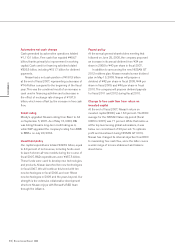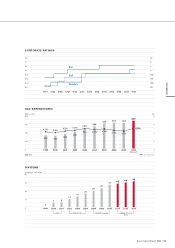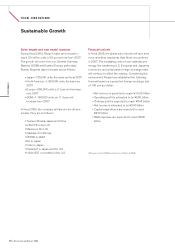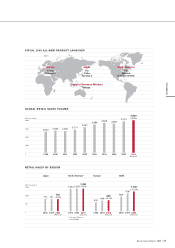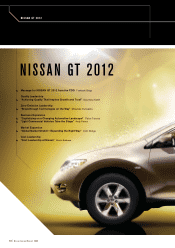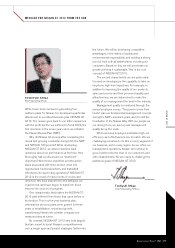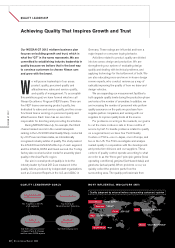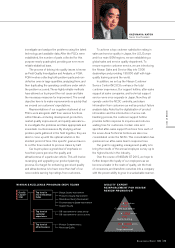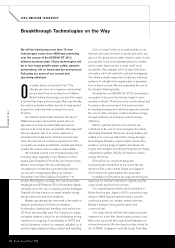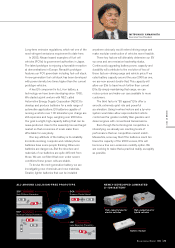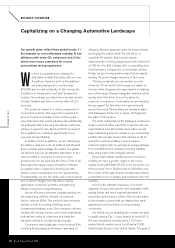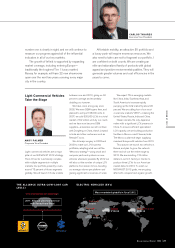Nissan 2008 Annual Report Download - page 26
Download and view the complete annual report
Please find page 26 of the 2008 Nissan annual report below. You can navigate through the pages in the report by either clicking on the pages listed below, or by using the keyword search tool below to find specific information within the annual report.
24 Nissan Annual Report 2008
NISSAN GT 2012
ZERO-EMISSION LEADERSHIP
Breakthrough Technologies on the Way
We will be introducing more than 15 new
technologies a year from 2009 and continuing
over the course of the NISSAN GT 2012
midterm business plan. These technologies will
be in four major growth areas: safety, dynamic
performance, life on board and the environment.
Following are some of our current and
upcoming advances.
Our safety theme is “accident free.” The
ultimate aim here is to engineer vehicles that
are accident-free. According to our “Safety
Shield” safety technology concept, this means
a vehicle that helps protect people. More specifically,
the vehicle activates multiple barriers to help protect
people from potential risks coming from every
direction.
An inflection point exists between the rate of
fatal/serious injury and vehicle speed, and our
approach is to help decrease fatal and serious
injuries to as close to zero as possible. This approach
has two aspects. One is to reduce speed to a
minimal level to help avoid collisions and minimize
risks. The second is to enhance protection for the
occupants, as well as pedestrians, cyclists and others
outside the vehicle when a crash is unavoidable.
We released several such innovations last year,
including major upgrades of our Distance Control
Assist, Lane Departure Prevention, and Around View
Monitor technologies. We are extending the
innovations to monitor the cars behind and next to
you as well—incorporating “Back-up Collision
Prevention” and “Side Collision Prevention”—to
provide 360-degree coverage. Our new Smart Auto
Headlight and GPS Mobile ITS for Pedestrian Safety
will help reduce the risk of crashes, and the Intelligent
Seatbelt will help improve occupant restraint during
abrupt maneuvers and skid situations.
Nissan cars already are renowned in the realm of
dynamic performance for their acceleration,
deceleration, braking and handling, such as the new
GT-R we launched last year. The evolution to realize
innovative dynamic control for an exhilarating driving
experience is ongoing. A combination of IT/ITS and
vehicle dynamics control, for example, will allow us to
achieve highly balanced riding comfort and handling.
“Life on board” refers to everything that occurs
between the time you enter a vehicle and when you
get out. Our goals are to make vehicles easier to own
and operate, to be more pleasant places to inhabit,
and to make data from the outside world more
accessible. One example is the Scratch Shield, an
innovation with both aesthetic and practical appeal.
The shield actually repairs fine scratches, restoring
surfaces to virtually their original state in anywhere
from a day to a week. We are expanding the use of
the Scratch Shield globally.
As stated in our NISSAN GT 2012 commitment,
our goal is to become the industry leader in zero-
emission vehicles. Therefore, we’re excited about and
focused on the environment. Our environmental
technology development has three aspects: promote
the use of clean energies, create innovative energy-
storage solutions, and enhance vehicle energy
efficiency.
Electric vehicles and fuel cell vehicles will
contribute to the use of clean energies. Our newly
developed laminated lithium-ion (Li-ion) battery will
enable us to come up with better energy-storage
technologies. Nissan’s original hybrid vehicle, Eco-
pedal eco-driving support system and advanced
engine technologies, including homogeneous-charge
compression ignition (HCCI), will improve vehicle
energy efficiency.
EVs will be our core technology and
environmental contribution to the world. We will
introduce EVs in the United States and Japan in
2010 and to the mass market two years later.
In addition to EVs, there are many technological
advances for internal combustion engines, hybrids,
clean diesels and fuel-cell vehicles.
Our original hybrid vehicle, which will debut in
North America and Japan in 2010, is another huge
advance. While typical hybrids produce smooth,
continuous power, our simpler system provides
Nissan’s dynamic driving performance and
conserves fuel.
Our clean diesels will offer the maximum power
response for a two-liter diesel engine, produce very
little noise, and meet the tough Euro4 standard on
exhaust emissions. We developed a clean diesel for
the X-TRAIL in Japan to meet the tough Post New


